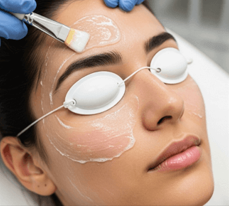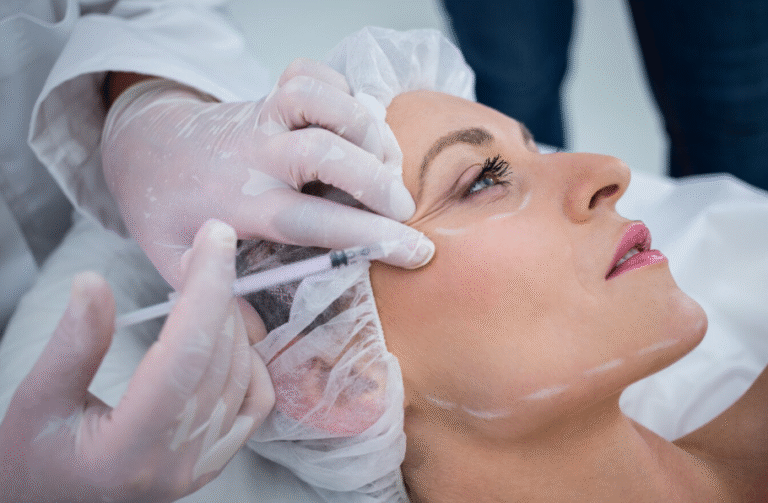Treatment Overview
Chemical peels are a supportive treatment in Korea for patients with redness, flushing, and sensitive skin caused by rosacea, post-acne erythema, or vascular reactivity. Unlike traditional strong peels for acne scars or pigmentation, Korean dermatology uses gentle, low-concentration peels (such as lactic acid, mandelic acid, gluconolactone, or enzyme-based formulations) to calm inflammation, smooth skin texture, and support barrier function without triggering irritation.
Korean clinics often integrate chemical peels into redness control programs, pairing them with anti-redness lasers, soothing infusions, and barrier creams. This approach emphasizes controlled exfoliation while strengthening skin tolerance and reducing vascular reactivity over time.
For redness and flushing, Chemical Peel Therapy:
- Reduces post-inflammatory erythema and residual acne redness.
- Smooths skin surface and unclogs pores without harshness.
- Improves absorption of anti-redness creams and serums.
- Supports skin barrier recovery when performed in clinic settings.
Purpose & Benefits
- Mild Exfoliation: Removes dead skin cells without over-stripping.
- Redness Reduction: Helps fade post-acne redness and supports rosacea care.
- Barrier Support: Korean peels often include hydrating or soothing agents.
- Flushing Control: Improves overall skin resilience to vascular triggers.
- Combination-Friendly: Enhances results when combined with lasers or infusions.
Ideal Candidates
Chemical Peel Therapy in Korea is recommended for:
- Patients with post-acne erythema (red marks after acne).
- Individuals with rosacea-prone skin seeking gentle resurfacing.
- Adults with sensitive, redness-prone skin who cannot tolerate strong acids.
- Patients undergoing combination therapy (peels + lasers + infusions).
- Those who want smoother skin texture while calming redness.
Comparison with Other Treatments
- Chemical Peels (Mandelic, Lactic, PHA, Enzyme): Gentle resurfacing + redness reduction; safe for sensitive skin.
- Anti-Redness Lasers (PDL, V-Beam, Nd:YAG): Directly target visible vessels; stronger vascular effect.
- Antibiotics (Doxycycline, Minocycline): Internal anti-inflammatory control; systemic effects.
- Beta-Blockers (Propranolol, Carvedilol): Best for adrenaline-driven flushing; systemic calming.
- Topical Anti-Redness Creams (Metronidazole, Brimonidine): Local redness control; short-term effect.
- Barrier Repair Creams (Centella, Panthenol, Madecassoside): Supportive for sensitivity but no exfoliation.
Possible Risks & Complications
When performed in clinic with mild agents, peels are safe, but may cause:
- Temporary tingling or stinging during application.
- Mild redness for 24–48 hours.
- Rare dryness or peeling if overused.
- Flare-ups if unsuitable peel type is chosen for sensitive rosacea skin.
Treatment Techniques Used
- Gentle Acids: Mandelic acid, lactic acid, PHA, or enzyme peels for redness-prone skin.
- Application: Thin layer applied for 2–5 minutes, then neutralized.
- Frequency: Every 2–4 weeks, depending on skin condition.
- Combination Therapy: Often followed by soothing masks, cooling infusions, or LED therapy.
- Clinic Integration: Performed under dermatologist supervision to avoid over-exfoliation.
Recovery & Aftercare
- First Week: Skin feels smoother, mild redness subsides.
- 2–4 Weeks: Post-acne erythema and uneven tone visibly improve.
- Maintenance: Monthly peels help sustain results.
Aftercare Tips:
- Avoid hot saunas, alcohol, or exfoliants for 3–5 days.
- Apply fragrance-free moisturizers and SPF daily.
- Use soothing creams with Centella or Panthenol.
- Follow clinic instructions for home care products.
Results & Longevity
- Short-Term (1–2 Weeks): Brighter, calmer complexion; smoother texture.
- Medium-Term (1–2 Months): Gradual fading of redness and post-acne marks.
- Long-Term: Stable skin tone with ongoing maintenance sessions.
Treatment Process in Korea
- Consultation & Diagnosis – Dermatologist evaluates redness type (rosacea, post-acne, sensitivity).
- Preparation – Skin cleansed, mild peel chosen for condition.
- Application – Peel applied, left for controlled time, then neutralized.
- Clinic Add-Ons – Soothing infusions, LED calming, or barrier masks post-peel.
- Follow-Up – Maintenance sessions scheduled monthly.
Why Korea is a Top Destination
- Use of gentle, customized peel formulations safe for sensitive skin.
- Multi-step clinic programs: peels paired with calming infusions and laser therapy.
- Affordable compared to Western dermatology packages.
- Emphasis on barrier recovery and skin health, not just exfoliation.
- Korean dermatologists are known for precision-tailored treatments for redness-prone skin.
Cost Range (Detailed Breakdown)
Pricing for Chemical Peel Therapy in Korea for redness & flushing:
- Single Gentle Peel Session: USD 60 – 150.
- Package of 3–5 Sessions: USD 200 – 600.
- Consultation Fee: USD 20 – 40.
- Clinic Add-Ons (Cooling masks, infusions, LED therapy): USD 50 – 120.
- Premium Redness Peel Program (Peels + Lasers + Infusions): USD 700 – 1,500 (3–5 sessions).
Additional Costs in Korea:
- Soothing barrier creams (Centella, Panthenol, Propolis): USD 30 – 80.
- Sunscreens for sensitive skin: USD 20 – 50.
💡 Patients often call Korean chemical peels the “gentle reset treatment”, since they smooth the skin surface while calming redness, making them safer for sensitive or rosacea-prone skin.
Popular Clinics in Seoul
- Oracle Dermatology – Gentle mandelic/lactic acid peels with redness laser add-ons.
- Banobagi Dermatology – Customized redness peel programs with barrier repair.
- Renewme Skin Clinic – Sensitive-skin peels paired with anti-redness infusions.
- View Plastic & Dermatology – Peel + LED therapy packages for flushing and post-acne redness.
- Chaum Anti-Aging Center – Premium redness management with enzyme peels, infusions, and vascular lasers.




